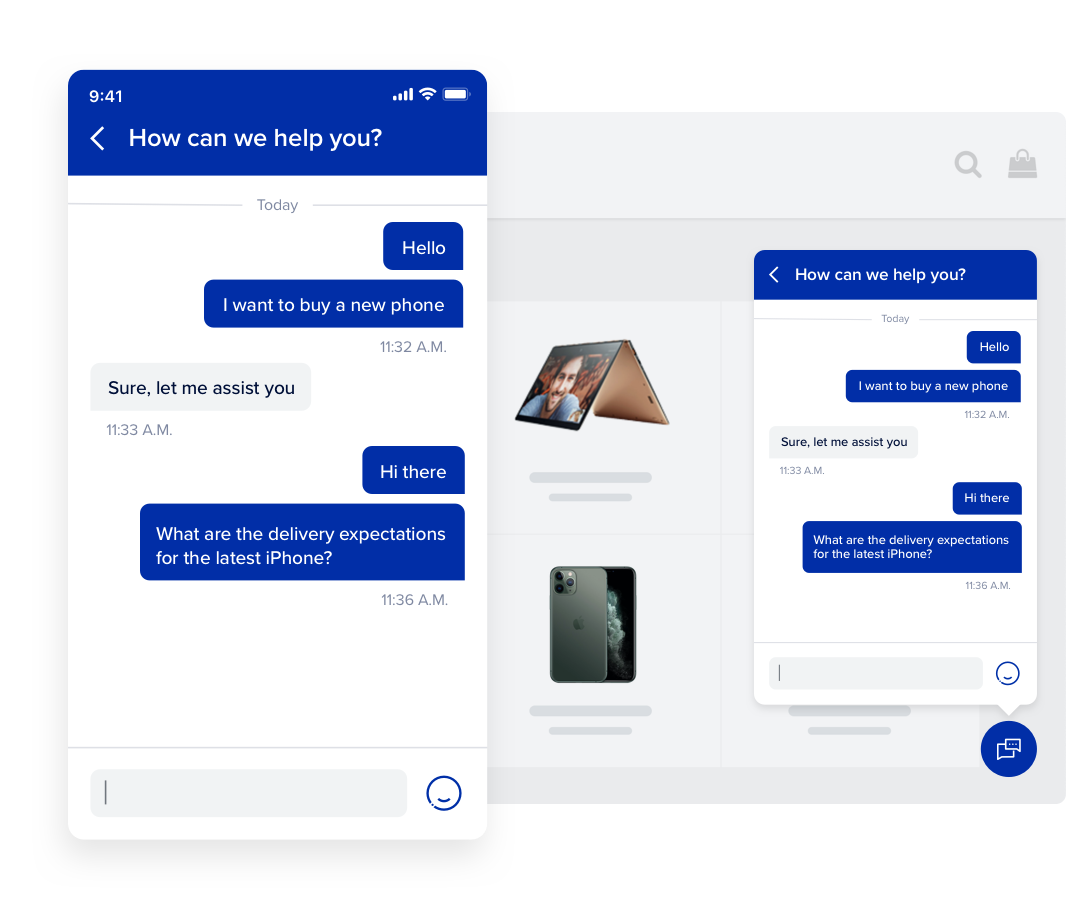What is a virtual agent?

Virtual agents (sometimes confused with chatbots) are everywhere. Almost every website and mobile app has one. They’re the messaging app-style window that pops up in the corner and greets you. But what exactly are they?
In its simplest form, a virtual agent is a piece of software that follows certain rules to provide answers or directions based on customer questions. How intuitive a conversation with it depends on just how complex that ruleset is. Most chatbots work this way, running off selected scripts and being programmed to answer common queries.
However, by adding in artificial intelligence (AI), you can move beyond this basic communication into something more detailed.
What is an AI-powered virtual agent?
An AI-powered virtual agent is more complex than a chatbot, making use of technology like machine learning and natural language processing (NLP). This allows it to be an active participant in conversation, acting more like a human.
Virtual agent vs virtual assistant
A virtual agent is different from a virtual assistant, so make sure not to confuse the two. The key difference between them is that virtual assistants are human agents while virtual agents are software.
A virtual assistant is a remote employee that handles tasks assigned by their employer. Some of their tasks might include:
- Scheduling appointments and managing calendars
- Making travel arrangements
- Taking and transferring phone calls
As mentioned earlier, an intelligent virtual agent is an automated software that can respond to a customer’s query. They are often presented as chatbots on websites, although they are far more advanced.
Let’s look at the differences between chatbots and virtual agents next.
Chatbot vs virtual agent?
As mentioned, chatbots are much simpler. For instance, if you ask a basic chatbot to track your order, it might just see ‘track my order’ and send you to the appropriate webpage. An intelligent virtual agent will take your order number and find out the information for you, before asking if there’s anything else it can help with.
These days, chatbots are relatively well equipped for common queries, and even some more complicated questions. They’re relatively easy to implement and often at a lower cost. If you only need something to deal with basic questions, gather customer information, or schedule a call-back, then chatbots can do the job.
Natural Language Processing
Virtual agents, however, can actively understand what a customer is saying, rather than scanning for certain phrases. They can grasp intent and provide personalized responses. If you want to use technology for troubleshooting, account management or more in-depth tasks, then they’re a much better choice.

However, AI isn’t magic. Virtual agents are only as good as the data sets they’re trained on. This is both a good and a bad thing. The good news? You can train them off your particular customer base, and they can develop through use. The bad news? If you don’t have a decent data set, they’re functionally useless.
Uses of virtual agents in contact centers
Virtual agents excel in contact centers, where they can reduce the workload of your team and manage early communications with customers. Three key areas to implement them are:
Customer service agents
Virtual agents shouldn’t replace your live chat agents, but they’re an invaluable addition to any customer service team. Many enquiries that customer service agents deal with are relatively routine, for instance:
- What’s the status of my order?
- What’s your return policy?
- One of my items is damaged, what can I do?
- When will this product come back in stock?
- Can I update my account details?
All of these can be answered by a virtual agent in real-time. Conversational AI allows the responses to feel more natural. This means that routine queries no longer require one of your team to write an email response or engage in a lengthy phone conversation. Instead, they’re resolved through the virtual agent. Customers go away happy, and employees have more time to deal with in-depth questions.
Live agents for IT support
Just like customer service, an IT helpdesk will have to deal with lots of routine requests. Password resets, software updates and basic troubleshooting can all be handled through messaging a virtual agent. Even for more complicated questions, a basic chatbot or AI-powered agent can take details and create a ticket.
Once again, this improves customer satisfaction due to fast responses, and frees up your IT staff from these mundane tasks.
Lead generation
Virtual agents and chatbots can also help your sales department, by assisting with lead generation. They provide a quick way to capture user information, and work out their intentions.

By having a virtual chat agent take details such as name, email and reason for contacting, you have enough information for your sales team to start pursuing a lead.
Benefits of virtual agents
Implementing a virtual agent has lots of benefits, for customers and employees. Some of the main benefits include:
1. Available 24/7
Providing customer service 24/7 is challenging for any business. You either need to employ enough staff for round-the-clock shifts, outsource to call centers in other timezones, or provide limited hours.
However, with a virtual agent you can have something available all the time. As mentioned, virtual agents can answer most routine questions. For more difficult enquiries, they can schedule a call-back or email from a human agent. While scheduling may not give an immediate answer, it still leads to increased satisfaction as the customer knows they’ve been heard.
2. Reduce pressure on human agents
The drive to constantly improve customer experience can put a lot of pressure on customer service agents. Often, staff are torn between wanting to provide in-depth personalized service and wanting to get through as many tickets or calls as possible.
By triaging requests through a virtual agent, you can reduce this. Staff no longer need to spend time on basic, simple problems, reducing the amount of requests they have to handle. While that means the questions that do come through are more complicated, they can spend more time answering them.
Virtual agents are a great way to improve employee satisfaction and customer engagement.
3. Gather actionable data in call centers
Since virtual agents have conversations through text, it makes them a great way to build up a pool of actionable data. Combined with other uses of AI and natural language processing, this data can be analyzed to produce helpful insights.
Expect to see information on the most common questions, what products have the most issues, and the main complaints or compliments you receive. You can also gather information on when people contact you, where they’re contacting from, and how long the average conversation lasts.
This information can be used to build up a self-service knowledge hub, further reducing the amount of communication you receive. Not only that, but remember: actionable data means improved business decision making.
4. Artificial intelligence constantly improves
Since many virtual agents are built using machine learning, they have the capacity to continuously improve. Combined with natural language understanding, this means that as their dataset grows, they grow in capability.
The more interactions an intelligent virtual agent has, the more information it has to work from. It will become better at ascertaining tone and intent. Not only that, but it’ll grow more familiar with what questions are asked of it and be able to provide better responses.
5. Improved customer experiences
Providing excellent customer service is vital to running a successful business. Virtual agents can help provide this by:
- Increasing the first response time
- Providing personalized answers
- Automation of routine tasks
- Reducing wait times/time spent on hold
- Allowing customer service agents to spend longer on each case
How do you make a virtual agent?
Having seen these benefits, you probably want to implement a virtual agent straight away. But how do you make one?
Getting started with a chatbot is relatively simple, as it doesn’t require conversational AI or other complex technology. It’s basically a case of providing responses to set phrases - and you can encourage use of these set phrases by providing them as options to the user.
However, making a virtual agent is more challenging. There are tools available that you can customize rather than making one from scratch. This is definitely easier if you don’t have a strong IT team familiar with artificial intelligence. You need to start by asking two questions:
How does omnichannel routing work?
Omnichannel routing works just like how routing calls did in traditional call centers, except it also has options for channels like email, SMS, and chat.
The first step in the routing process is the qualifying phase. During this phase, an incoming call is sent through interactive voice response (IVR). An IVR feature helps determine a customer’s concern by letting them select choices from a set of menus. If you’ve heard something like “Press 1 for transaction inquiries”, that is an example of an IVR. It’s similar to an automated agent.
Next, an automated call distributor (ACD) places the inbound calls in a queue. This is where skill-based routing comes into play. The ACD will take the customer’s responses in the IVR and create a call assignment based on agent skills and experience.
- What capabilities should the virtual agent have?
- What can’t a virtual agent do?
The first question will help you determine functionality, while the second will ensure you work within reasonable constraints. If you’re building one from the basics up, you’ll need a comprehensive data set for it to learn from, natural language processing capabilities, and expected workflows.